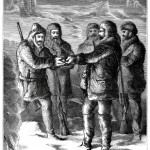I re-read my last post a day after writing it and amended the first line, since I found it misleading. It was the worst flu pandemic ever, but I knew that smallpox, the Black Plague, AIDS, malaria and perhaps even typhus each have caused nearly as many or even more deaths over a period of years. I eventually found a rather strange, non-medical website with the "7 Worst Killer Plagues in history," and confirmed my belief that no other bacteria or virus had wreaked as much havoc in brief span of time as the 1918-1919 H1N1 influenza virus.
I wanted to find out what happened to that highly pathogenic organism and, after searching the web, realized the PBS article on the "Spanish flu" was a good place to start. It mentions that the influenza virus was not identified until 1933 and that the actual genetic identity of the particular strain involved in that pandemic (as opposed to the basic type...H1N1) was not identified for many years. The influenza virus responsible for the 1918-1919 pandemic has had many descendants, none as deadly as their ancestor.
In 1950, Johan V Hultin, a graduate student starting his doctoral studies in microbiology, got a clue from a visiting professor who suggested hunting for the virus in bodies buried 32 years prior in the permafrost of the Arctic. Hultin and his faculty advisor traveled to Alaska where flu among the Inuits had been especially deadly with 50 to 100% death rates in five villages.
Gold miners, under contract with the Territorial government, had served as grave diggers in 1918-1919 and tissue samples were recovered from four bodies exhumed in 1951. Pathology slides fit with viral lung damage and, in some cases, secondary bacterial pneumonia. But tissue cultures from the samples did not cause disease in ferrets and no influenza virus was recovered.
It wasn't until 1995 that science had advanced enough to for researchers to start the work necessary to identify the virus's unique features. Jeffrey Taubenberger, a molecular pathologist then working at the Armed Forces Institute of Pathology (AFIP), began a ten-plus-year-long project starting with autopsy tissues from the time of the pandemic that had been preserved in the National Tissue Repository. His project was stimulated by a paper published in the journal Science in February, 1995, in which preserved tissue samples from the famous British scientist John Dalton (often called the father of modern atomic theory) were examined. Dalton was color-blind and had donated his eyes at his death in 1844 to determine the cause of the defect; his DNA was studied 150 years later and the resultant publication gave Taubenberger the impetus to do the same with the flu virus.
Hultin read the first paper from Taubenberger's group, wrote to him and eventually went back to Alaska to exhume more flu victims. One was an obese woman whose lungs had the findings of acute viral infection. Samples of these permafrost-preserved tissue had RNA incredibly similar to those obtained from the AFIP National Tissue repository.
And so began an amazing chapter in the history of virology.
Tags: genome sequencing, H1N1 virus, influenza, influenza vaccination, pandemics, Virology


